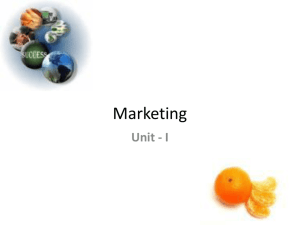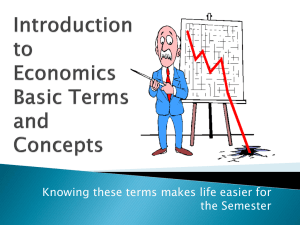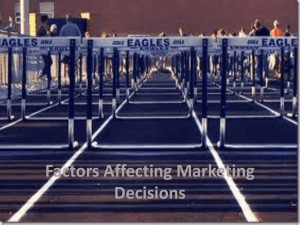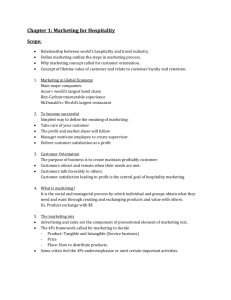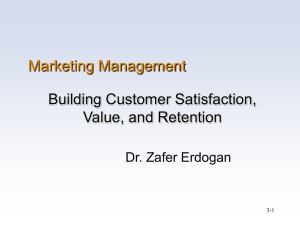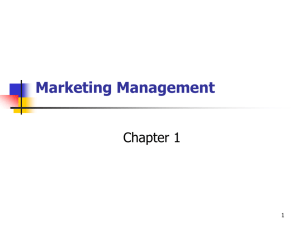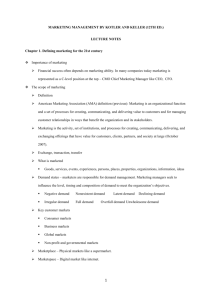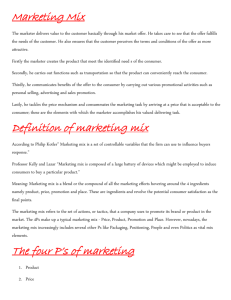1 Sample Exam Questions for Chapter 1 Marketing Mix, Marketing
advertisement
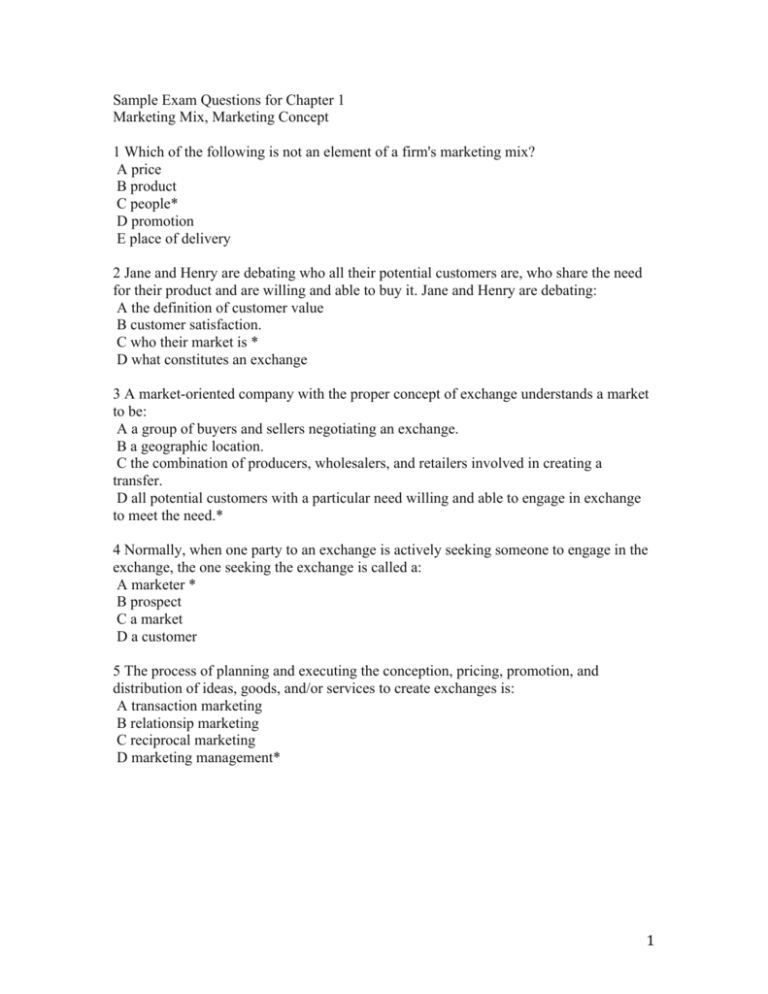
Sample Exam Questions for Chapter 1 Marketing Mix, Marketing Concept 1 Which of the following is not an element of a firm's marketing mix? A price B product C people* D promotion E place of delivery 2 Jane and Henry are debating who all their potential customers are, who share the need for their product and are willing and able to buy it. Jane and Henry are debating: A the definition of customer value B customer satisfaction. C who their market is * D what constitutes an exchange 3 A market-oriented company with the proper concept of exchange understands a market to be: A a group of buyers and sellers negotiating an exchange. B a geographic location. C the combination of producers, wholesalers, and retailers involved in creating a transfer. D all potential customers with a particular need willing and able to engage in exchange to meet the need.* 4 Normally, when one party to an exchange is actively seeking someone to engage in the exchange, the one seeking the exchange is called a: A marketer * B prospect C a market D a customer 5 The process of planning and executing the conception, pricing, promotion, and distribution of ideas, goods, and/or services to create exchanges is: A transaction marketing B relationsip marketing C reciprocal marketing D marketing management* 1 6 The first computers originated for home use were only sold in kit form to technical enthusiasts who did their own assembly. Demand was high and so were prices. At that time, the firm offering these kits would likely be using the ______concept. A production B market C product * D selling/sales 7 Texas Instruments, one of the first producers of handheld calculators, put a great deal of effort into expanding production of calculators to drive down the cost and thus expand the market. This is most indicative of the __________ concept: a production* b product c marketing d societal 8 The old adage, "Build a better mousetrap and the world will beat a path to your door," is a ______concept. A production B product* C marketing D selling/sales E don't know 9 Which of the following should not be considered one of the controllable elements in a firm's marketing strategy: A price selection. B selection of a target market. C salesforce design D promotion E the economic environment* 10 The marketing mix tool that is the most difficult to modify in the short run is: a price. B place and channels of distribution* C sales force size. D advertising expenditures. E all are equally easy to modify 11. The set of controllable tactical marketing tools-product, price, place, and promotion that the firm blends to produce the response it wants in the target market. a) Marketing Mix* b) Demand Management c) Supply Management d) Sales Management e) Customer Manipulation 2 12. The American Marketing Association defines marketing as "the activity, set of institutions, and processes for creating, communicating, delivering, and exchanging offerings that have value for customers, clients, partners, and society at large". a) True* b) False 13. Big M marketing refers to the strategic, long-term, firm-level commitment to investing in marketing. a) True* b) False 14. If you have a Monopoly you do not have to do any marketing. a) True b) False* 15. Value may be defined as the ratio of bundled benefits received to the cost incurred by the customer to receive those benefits. ____________ is not thought of as one of the costs. a) Monetary cost b) Time to shop c) Skill or expertise d) Poor service quality e) Customer satisfaction* 16. Henry Ford is well known to business students for creating the assembly line that enabled mass production of the Model T. This is often cited as an example of the _____________. a) Production orientation* b) Selling orientation c) Marketing orientation d) Buzz marketing orientation e) Business orientation 17) The goal of the Marketing Manager is to maximize customer satisfaction. a) True b) False* 3 18) Creating, communicating, delivering and exchanging offerings that have value may be thought of as ___________________. A. The marketing mix or 4 Ps * B. The firm's strategic plan C. Sales orientation D. Production orientation E. Exchange 19) Value focuses on _____________________. A. Product design B. Branding and positioning C. Attention to service D. Pricing E. All of the above* 20) The simple 1950-style versions of the marketing concept were based on the idea of having a company-wide customer orientation with the objective of achieving long-term profits. a) True* b) False 21) The simple 1950-style version of the marketing concept has been enhanced with more details about the customer orientation, relationship orientation, one-to-one marketing, mass customization, and the return on marketing investment. a) True* b) False 22) The modern marketing concept can be stated as a philosophy of competition in which the organization’s goal (e.g., profit) is achieved by identify and targeting a group of profitable customers with relatively homogenous needs and wants and delivering the desired solutions and satisfactions to those customers through an integrated marketing mix more efficiently and more effectively than the competitors. a) True* b) False 23) _____________ is not part of the marketing mix. A. Product B. Distribution C. Promotion D. Price E. Manufacturing * 4 24) High tech media options like cell phones and the internet have had a huge impact on the ________ aspect of marketing A. Product B. Promotion * C. Price D. Distribution E. Research 25 The long-term objective of strategic marketing is ____________. A. Customer satisfaction at all costs B. Profitability through building a customer-oriented organization* C. Understanding where the company with be in 10, 20, 30 years D. Getting ahead while doing well in society E. Studying the competition 26) Today many CEOs and shareholders expect to measure results of marketing efforts because ___________. A. Marketing metrics today are designed to assign specific results to specific marketing programs* B. They are unrealistic in believing that all marketing is measurable C. It is easy to do D. All of the above E. A and C 27) Marketing misnomers occur because many people think of marketing as __________. A. Pushy salespeople B. Advertising and celebrity spokespersons C. The firm's department of advertising D. Overstated product claims E. All of the above* 5
